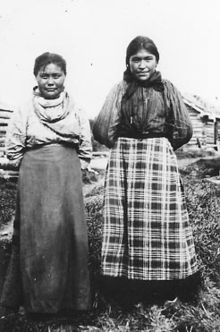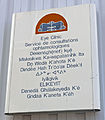Slavey
Awokanak | |
|---|---|
 Slavey girls, Mackenzie River, Northwest Territories | |
| Total population | |
| 2,630 (2016 census)[1] | |
| Regions with significant populations | |
| Canada (Northwest Territories, Alberta) | |
| Languages | |
| English, North and South Slavey language | |
| Religion | |
| Animism, Christianity, Slavey Religion | |
| Related ethnic groups | |
| Sahtu (North Slavey) |
The Slavey (also Awokanak, Slave, and South Slavey) are a First Nations group of Indigenous peoples in Canada. They speak the Slavey language, a part of the Athabaskan languages. Part of the Dene people, their homelands are in the Great Slave Lake region, in Canada's Northwest Territories, northeastern British Columbia, and northwestern Alberta.
Name
[edit]Cree exonym "slave"
[edit]Slavey or just Slave is a translation of Awokanak,[2] the name given to Dene by the Cree "who sometimes raided and enslaved their less aggressive northern neighbors [sic]".[3][4][5] The names of the Slave River, Lesser Slave River, Great Slave Lake, and Lesser Slave Lake all derive from this Cree name. Esclaves remains incorporated in the French names of these geographical features, since the French traded with the Cree before the English did. The people now called Slavey in English were not necessarily taken as slaves in that period.
Dehcho autonym
[edit]The name Slavey is seldom used by the people themselves, who call themselves Dene. Indigenous ethnonyms for South Slavey people and language are Dehcho, Deh Cho Dene ("Mackenzie River People") or Dene Tha.[6]
Though most Athabaskan peoples call themselves Dene, those in the Northwest Territories tend to use it for their particular group specifically. However, the northern Slavey are also known in English as the Sahtú, while the southern band are known as the Deh Cho.[7]
Groups
[edit]The South Slavey live in northwestern Alberta, northeastern British Columbia, and the southern Northwest Territories. First Nations of South Slavey people:[8]
- The Fort Nelson First Nation (Treaty 8)[9] in British Columbia. Own name: Dene "the people", for language Dene k'e. Historical literature Fort Nelson Indian Band, Fort Nelson Slavey Band, Fort Nelson Indians.
- The Dene Tha' First Nation in Alberta. Own name: for people Dene Tha' or Dene Dháa "ordinary people", for language Dene Dháh. Historical literature by a number of names, including the following: Upper Hay River Band; Hay Lake(s) Band; Hay River Indians; Slave Band; Slavey Indians at Hay Lake(s); Upper Hay River Post Indians; and Bistcho Lake Tribe.
- The Dehcho First Nations (also called Deh Cho Dene – "Mackenzie River Dene"[10]) in the Northwest Territories:
- Acho Dene Koe First Nation – Fort Liard (Ahcho Koe or Ahcho Kue)
- Deh Gáh Got'ı̨ę First Nation – Fort Providence (Zhahti Koe or Zhahti Kue)
- Jean Marie River First Nation (Tthe'K'ehdeli Dene) – Jean Marie River (Tthek'éhdélį or Tthek'edeli)
- Katl'odeeche First Nation (Kátłʼodehche Dene[11]) – Hay River with Hay River Reserve (Xátł'odehchee)
- Ka'a'gee Tu First Nation (Ka'agee Tu Dene) – Kakisa (K'ágee)
- Łı́ı́dlı̨ı̨ Kų́ę́ First Nation (Liidli Kue Dene) – Fort Simpson (Liidli Kue)
- Nahɂą Dehé Dene Band (N'ah adehe Dene) – Nahanni Butte (Tthenáágó)
- Pehdzeh Ki First Nation (Pehdzeh Ki Dene) – Wrigley (Pehdzeh Ki)
- Sambaa K'e First Nation (Sambaa K'e Dene) – Sambaa K'e
- West Point First Nation – West Point (Ts'ueh Nda – Spruce Point), headquartered in Hay River

The Sahtu, Sahtu Dene ("Great Bear Lake People") or North Slavey people live exclusively in the Northwest Territories. They speak the North Slavey language.
The Navajo people (Diné) of the Four Corners region of the Southwestern United States are said to be descended from the Nahani, who lived where the Nahanni National Park Reserve is, and also the Slavey of Northern Canada.[12]
In popular culture
[edit]Most residents of Lynx River, the fictional town in which CBC drama North of 60 is set, are Slavey. Though the word itself is seldom mentioned in dialogue (band members generally identifying themselves as Dene), the town is located in Slavey territory and on one occasion a character proposes a toast before the assembled members in the Slavey language.[citation needed]
Image(s)
[edit]-
Sign for government-run eye clinic in Yellowknife, with all 11 official languages of the Northwest Territories (from top to bottom: English, French, Chipewyan, Cree, Dogrib, Gwichʼin, Inuktitut = ijinniarvik, Inuvialuktun/Inuinnaqtun, North Slavey, South Slavey)
-
Prince of Wales Northern Heritage Centre, languages in order of appearance: English, South Slavey, Tłı̨chǫ (Dogrib), Chipewayan, French
See also
[edit]- Slavey Jargon (Broken Slavey)
References
[edit]- ^ "Aboriginal Ancestry Responses (73), Single and Multiple Aboriginal Responses (4), Residence on or off reserve (3), Residence inside or outside Inuit Nunangat (7), Age (8A) and Sex (3) for the Population in Private Households of Canada, Provinces and Territories, 2016 Census - 25% Sample Data". www12.statcan.gc.ca. Government of Canada. 25 October 2017. Retrieved 23 November 2017.
- ^ "Slave | African-American, Abolitionists, Emancipation | Britannica". www.britannica.com. Retrieved 3 October 2023.
- ^ Waldman, Carl (2006). Facts on File Library of American History - Encyclopedia of Native American tribes. Infobase Publishing. p. 275. ISBN 9781438110103.
- ^ Pritzker, Barry (2000). A Native American encyclopedia : history, culture, and peoples. Oxford University Press. p. 512. ISBN 9780195138979.
- ^ "Yellowknife hotel with 'slave' in name stokes conversation on reclaiming Indigenous names".
- ^ Rice, Sally (2009). "Athapaskan eating and drinking verbs and constructions". In Newman, J. (ed.). The Linguistics of Eating and Drinking (PDF). Amsterdam, NL; Philadelphia, PA: John Benjamins. pp. 109–152. Contemporary, indigenous ethnonyms for some of the Athapaskan languages represented in this paper are given in parentheses after the term likely to be more common in the traditional linguistic and anthropological literature: Babine (Witsuwit'en), Chipewyan (Dene Sųłiné), Navajo (Diné), Sarcee / Sarsi (Tsuu T'ina) South Slavey (Dehcho or Dene Tha), North Slave (Sahtu).
- ^ "Dehcho First Nation".
- ^ Dene Tha' Presence in Northeastern BC (Prepared by: Randy Bouchard. Prepared for: Calliou Group, Calgary, Alberta on Behalf of the Dene Tha' First Nation, 14 July 2009)
- ^ Fort Nelson First Nation
- ^ Shirleen Smith 1999. Dene treaties, anthropology and colonial relationships. A thesis submitted to the Faculty of Graduate Studies and Research in partial fulfilment of the requirements for the degree of Doctor of Philosophy, Department of Anthropology, University of Alberta. Edmonton, Alberta, Spring 1999. [Chapter 2. In this chapter, I use the term "Slavey" in summarizing the ethnographic descriptions of Deh Cho Dene. I should clarify that this is not the term Dene use to describe themselves. In the Deh Cho region, Dene have a number of names for their people, for example: Dene from Acho Kue refer to themselves as Acho Dene, and the "Mountain Dene" from Fort Norman (part of the Deh Cho First Nations Council) refer to themselves as the Begade Shotagotine. A much more detailed discussion of Dene names is warranted for future work.]
- ^ South Slavey Topical Dictionary Kátłʼodehche Dialect
- ^ For example, the Great Canadian Parks website suggests the Navajo may be descendants of the lost Naha tribe, a Slavey tribe from the Nahanni region west of Great Slave Lake. "Nahanni National Park Reserve". Great Canadian Parks. Retrieved 2 July 2007.
Further reading
[edit]- Asch, Michael. Slavey Indians. S.l: s.n, 1978.
External links
[edit]- Map of Northwest Coast First Nations Archived 2012-11-29 at archive.today (including South Slavey (Dene-Tha)
- MNSU Slavey page
- An account of interactions between Slaveys and George Hunter
- Herbermann, Charles, ed. (1913). . Catholic Encyclopedia. New York: Robert Appleton Company.


